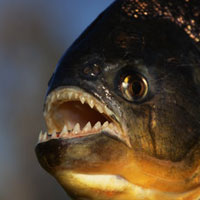|
|
Fish Breeding - Breeding Piranhas
Breeding Piranhas
by William Berg
 Piranhas
are a unique creature that has won its so popularity,
not only because of its appearance, but also due to the
many myths they are told in. Unfortunately only a few
species having been breed, some of the species that have
commonly bred include Serrasalmus nattereri, S. spilopleura,
S. gibbus, S. rhombeus. Another species that is considered
relatively easy to breed is S. maculatus. Piranhas
are a unique creature that has won its so popularity,
not only because of its appearance, but also due to the
many myths they are told in. Unfortunately only a few
species having been breed, some of the species that have
commonly bred include Serrasalmus nattereri, S. spilopleura,
S. gibbus, S. rhombeus. Another species that is considered
relatively easy to breed is S. maculatus.
Whichever you choose, you should have an aquarium that
is at least 100 gallons. A group of 5-6 piranhas is quite
appropriate, however if you want them breeding, the best
is to keep them in pairs so that there are no other fishes
to bother them. To find ae mating pair, you can pick two
adult Piranhas, one is thick and the other is thinner.
In most cases, thick piranhas represent females and thinner
Piranhas represent males. Just make sure you are not looking
at them after they have been fed. Though having found
males and females doesn't automatically mean success,
it is however a step on the way.
The ideal temperature is between 73-83F. Standard fluorescent
bulbs are fine for the lighting. Notice that they also
like some protective cover. You should also make the lighting
of half of the aquarium darker than the other. Piranhas
are hardy fish but it iss a good idea to maintain the
water clean and clear. In their original habitat, Amazon
River, rainy season is the time when most fish spawn.
Frequent and bigger water changes seem to have an immense
effect on the success of breeding (as they simulate the
rainy season) and most likely getting the piranhas into
breeding condition. When your piranhas lose all their
color and turn almost completely black, you can expect
that they are in breeding condition! Both of them may
start to protect a certain spot and chasing off other
piranha that come too close. If they start picking up
gravel in their mouth like digging for something, it usually
means they have already begun the mating process. Be careful
not to disturb your piranhas during this time! The female
will release eggs into the pit, and then leave the nest
but might stay close by it., The male is usually the one
that is responsible of guarding the nest and eggs. The
number of eggs laid is variable from 700-4000. The eggs
hatch in 2-3 days.
If you are lucky enough to have reached this stage, then
it's time to take care of the fry. Prepare a 10 to 15
gallon tank with heater and under gravel filter for the
fry to be moved into. Water should be from the parents'
tank. Be very, very careful when doing this, as the parents
can be extremely protective and aggressive. The fry will
quickly absorb their yolk sac and you will have to start
feeding them live baby brine shrimp as food.
One thing you should carefully notice is the legal issues.
Some states do not allow the sell or ownership of Piranhas
at all. Other states require that you obtain a permit
to sell or own a Piranha. Be sure to check to see if any
local restrictions apply before purchasing your piranha.
About the Author
William Berg Has over 20 years of aquarium experience.
He runs the website http://www.aquaticcommunity.com which
features a lot of information about all kinds of tropical
fish such as cichlids, predatory fish and crayfish. He
also written thi text about Clownloaches |
|
